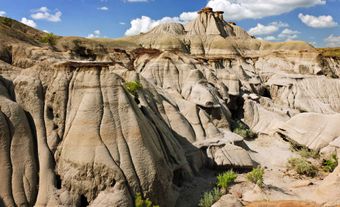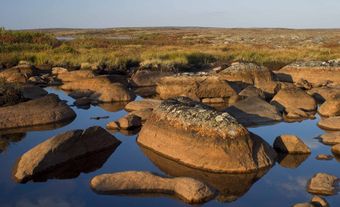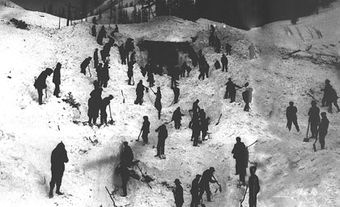
An iceberg is a piece of ice that has become detached from its parent glacier by a process known as calving. In Canada, icebergs mainly originate from west Greenland glaciers and travel south along the country's eastern seaboard.
Formation
An iceberg’s parent glacier may be flowing into a fjord, or may be a large, floating glacier extending many kilometres beyond the coastline, known as an ice shelf. Icebergs calve from these parent glaciers as a result of the manner in which the glacier enters the water, or subsequently from tidal and wave action or possibly as a result of earthquake vibrations. Less commonly, small icebergs result from forces acting on part of a glacier under water. In these cases icebergs may suddenly emerge from below water level. Increasingly, iceberg formation is influenced by climate change.
Once created, icebergs may melt or disintegrate, giving rise to smaller pieces called "growlers" and "bergy bits."
Appearance

Most icebergs are white except along freshly calved ice cliffs, which tend to appear blue. Others may appear green, brown or black, or combinations of these colours. These icebergs have usually rolled over, exposing the ice at their base, or have emerged from below water level. The various colorations are caused by differences in density, air-bubble content and impurities. For example, black ice has a high density and is bubble free; dark layers indicate the presence of rock materials derived from the base of the parent glacier. Occasionally, rocks may be found on the original upper surface of the iceberg. As the iceberg melts, these materials sink to the bottom of lakes and oceans as sediment.
Occurrence and Location and Dimensions
Some icebergs are trapped in lakes (for example, Lowell Lake, Kluane National Park) but the vast majority are found in oceans. Icebergs with a flat top are known as “tabular” icebergs. In the Antarctic they are commonly several tens of kilometres square and several hundred metres thick. One of the largest tabular bergs ever viewed measured 160 km by 72 km and one of the longest measured 185 km. A typical height above the waterline is 35–45 m, implying a total ice thickness of 250–320 m, although much greater thicknesses are possible. In the Arctic Ocean, the term ice island is applied to pieces of floating shelf ice that form principally on the north coast of Ellesmere Island. These thin, tabular icebergs are typically 30 m thick, often up to 100 km2 in area, and generally protrude 2–6 m above water.
Irregularly shaped icebergs are more typical of coastal Greenland and northern Canada. Many irregular bergs originate in Greenland fjords containing fast-flowing glaciers coming from the inland ice sheet. Because these glaciers usually terminate below the snow line and are often extremely broken up — first in their journey to the sea and then by tidal and wave action — they can give rise to very irregular bergs of almost pure ice, their spires occasionally reaching 100 m above sea level.
Dynamics and Stability
The composition of Antarctic tabular bergs gradually changes from snow on the top surface to ice by about the waterline. This fact, combined with their tabular shape, makes them much more stable than typical Arctic icebergs, which quickly tilt and finally roll on their voyage to destruction. Calving from an already tilted iceberg may shift the centre of gravity enough to cause the iceberg to roll, posing a threat to ships.
such as wind and wave action, especially during storm conditions, may significantly influence the short-term motion of an iceberg. Melting below sea level takes place slowly but continuously; above sea level, intermittently, and according to location and season.
Because the ocean transmits wave energy, icebergs respond to wave action. Thus, in addition to drifting with ocean currents, icebergs are known to oscillate vertically and to roll with a periodic motion. Since icebergs possess natural periods of oscillation dependent on their density and their thickness, they may tune in to certain ocean waves.
Depending on the shape of the iceberg and its rock content, the volume of ice submerged compared to the total ice volume is in the ratio of the density of the ice to that of seawater, or about 0.88 in Arctic and 0.85 in Antarctic icebergs. The above-water shape of an irregular iceberg does not necessarily provide information about its underwater geometry; it may be revealed, however, through the use of airborne radar or side-scan sonar from a ship. These studies and others (e.g., towing tests and iceberg-stability investigations) are carried out at the Centre for Cold Ocean Resources Engineering (C-CORE) in St. John's, Newfoundland.
Applications
Arctic ice islands on which aircraft can land have been used intermittently by the United States and Russia as mobile research platforms for about the last 30 years. Since 1985, a Canadian station has been maintained on an ice island that calved from the Ward Hunt Ice Shelf in 1983. Because many ice islands become trapped in Arctic Ocean current gyres, they may survive for many years, melting and crumbling at the edges.
Human Activity
In the Northern Hemisphere, icebergs present a threat to human activities. Off the coasts of Newfoundland and Labrador, current petroleum explorations necessitate the presence of drill platforms, which may be endangered by icebergs. In the vicinity of Valdez, Alaska, the Columbia Glacier is showing signs of disintegration in its terminal region. As a result, bergs could drift into Prince William Sound and pose a danger to oil tankers operating from the port of Valdez.
US Geological Survey glaciologists can post iceberg forecasts. Oil and gas operations in the Beaufort Sea and between the Queen Elizabeth Islands are threatened by collisions between even small ice islands and drill platforms or pipelines. The threat to shipping in the North Atlantic is now minimal, as a result of the establishment of the International Ice Patrol after the sinking of the Titanic in April 1912.
Climate Change
icebergs act as indicators of climate change. For example, warmer waters near calving fronts have likely contributed to increased rates of calving. Between 2005 and 2010, average summer temperatures on the Queen Elizabeth Islands were higher than they were in the preceding 60 years.
The Ward Hunt Ice Shelf serves as an example of how warmer temperatures affect the Queen Elizabeth Islands.The ice shelf, which is at least 3,000 years old, is the largest in the Arctic and lies along the northern coast of Ellesmere Island. In 2002, several large icebergs calved from the shelf, and a large fracture appeared. Several more fractures and additional calving have occurred since, including a 50 km2 ice island that broke away in 2010.
Aside from acting as general reminders of climate change and the resulting shifts in landscape, the breakup of ice shelves and the creation of icebergs pose environmental challenges of their own. For example, before it began to break apart, the Ward Hunt Ice Shelf acted as a dam for an epishelf lake (a body of freshwater floating on top of denser salt water). When the shelf fractured, the lake drained into the Arctic Ocean, taking with it a rare microbial ecosystem that may have included undiscovered species. Similarly, sea-ice ecosystems form the base of the Arctic food chain, and loss of sea ice affects many animals, from zooplankton to polar bears.
Rapid loss of sea ice and increased iceberg calving is also occurring in Antarctica. Due to the continent’s extreme cold and desert-like conditions, few land animals reside there. Antarctica’s marine species, however, are diverse and numerous by comparison. Researchers note that an increased number of icebergs, as well as their ability to drift in an increasingly ice-free ocean, are harming this biodiversity. As the icebergs move their submerged portions may drag along the sea floor, killing much of the marine life they come in contact with.

 Share on Facebook
Share on Facebook Share on X
Share on X Share by Email
Share by Email Share on Google Classroom
Share on Google Classroom


